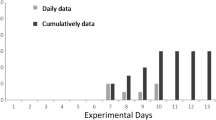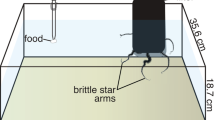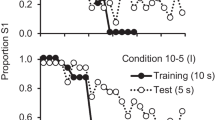Abstract
Goldfish were trained in reversal, nonreversal, and irrelevant shift situations with 60 or 100 preshift trials. The relevant dimensions were click and light. The attributes on the click dimension were high versus low intensity click. The attributes on the light dimension were high versus low intensity light. If the relevant stimulus was in the compound, the fish experienced the unconditioned stimulus (shock) at the end of the compound stimulus presentation. The unconditioned response and the conditioned response were the decrease in breathing that was initiated by the shock. The fish took longer to learn the irrelevant shift than the reversal or nonreversal shift. Fish, unlike other lower animals, did not learn nonreversal shifts faster than reversal shifts. No evidence was obtained for an overtraining reversal effect.
Similar content being viewed by others
References
BITTERMAN, M. E. 1966. Animal learning. In J. B. Sidowski (Ed.), Experimental methods and instrumentation in psychology. New York: McGraw-Hill.
FAY, R. R., & MACKINNON, J. R. 1969. A simplified technique for conditioning respiratory mouth movements in fish. Behavior Research Methods and Instrumentation, 1, 123–124.
GUILFORD, J. P., & FRUCHTER, B. 1973. Fundamental statistics in psychology and education (5th ed.). New York: McGraw-Hill.
HURST, J. W., & WOLACH, A. H. 1975. Deprivation conditions as determinants of differences in fish (Carassius auratus) and rat performance. The Psychological Record, 25, 355–362.
KELLEHER, R. T. 1956. Discrimination learning as a function of reversal and nonreversal shifts. Journal of Experimental Psychology, 51, 379–384.
MACKINTOSH, N. J. 1969. Further analysis of the overtraining reversal effect. Journal of Comparative and Physiological Psychology Monograph, 67, No. 2. Part 2.
REID, L. S. 1953. The development of noncontinuity behavior through continuity learning. Journal of Experimental Psychology, 46, 107–112.
TENNANT, W. A., & BITTERMAN, M. E. 1973. Some comparisons of intra-and extra-dimensional transfer in discriminative learning of goldfish. Journal of Comparative and Physiological Psychology, 83, 134–139.
WOLACH, A. H., BREUNING, S. E., ROCCAFORTE, P., & SOLHKHAN, N. 1977. Overshadowing and blocking in a goldfish (Carassius auratus) respiratory conditioning situation. The Psychological Record, 27, 693–702.
Author information
Authors and Affiliations
Rights and permissions
About this article
Cite this article
Zella, W., Wolach, A.H. Reversal and Nonreversal Shifts in a Goldfish (Carassiusa Ura Tus) Classical Conditioning Situation. Psychol Rec 30, 25–37 (1980). https://doi.org/10.1007/BF03394652
Published:
Issue Date:
DOI: https://doi.org/10.1007/BF03394652




